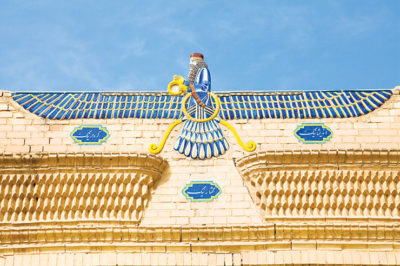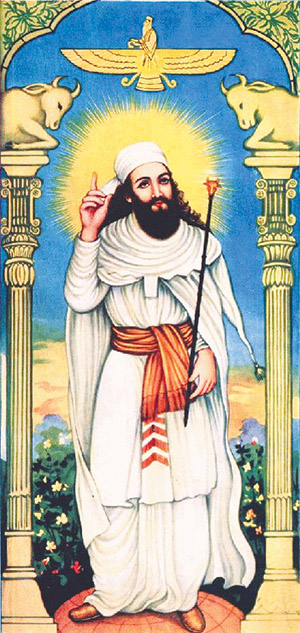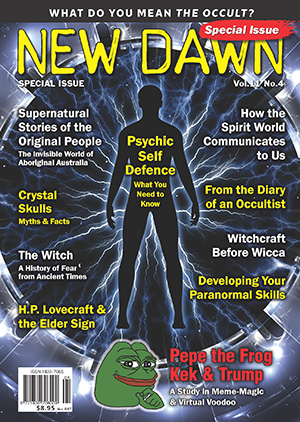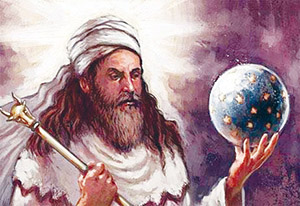From New Dawn Special Issue Vol 11 No 4 (Aug 2017)
One of the enduring signs of the origin of consciousness beyond the limits of our present planet is that of the Persian Faravahar – a winged disk mounted by the figure of a human being. In tradition this is a symbol of the fravashi, individual consciousness, but many also see it as an indication of the instillation of consciousness in humanity by higher beings. This it is as well.
The speculation surrounding this sign and its heritage recently received a boost when it was rumoured that in the summer of 2011 the American armed forces discovered a cave in Afghanistan containing the remnants of an ancient spacecraft (vimana). Reputedly the cave also contained inscriptions indicating the cave and its contents belonged to the ancient Iranian Prophet Zarathustra. Such narratives may or may not be true. The point of the present article is to delve into the little-known doctrines of the magical religion of Zarathustra and its unfolding in the West today.
Zarathustra, who probably lived around 1700 BCE, is the father of true religion, that is, a set of ideas and practices that can be adopted by anyone from any tribe or nation. This is because he had the flash of insight that the gods and goddesses of the traditional cult of which he himself was a trained priest were but extensions or emanations of One God: Consciousness. This one god he called Ahura Mazda, or Lord-Wisdom. This entity is one, yet it is dual-aspected, male and female, Ahura (Lord) is masculine, Mazda (Wisdom) is feminine.
In Zarathustra’s mind this insight (daena) also indicated that all humans were originally exponents of this god and that if people could come to see the Truth the Prophet was explaining, each individual could return or revert to the true religion which was his or her birth-right as a human being.
The word daena means both ‘insight’ and ‘religion’. (In Modern Persian it is din [deen].) Instead of seeing ‘religion’ as a strict set of rules and regulations, it is a higher mode of action to strive for insight, or true inner transformation – good thoughts, words and deeds follow from one’s being rather than as a result of trying to follow rules or laws.
The magical religion founded by Zarathustra came to be called the Beh Din, ‘the Good Religion’. At first it was a universal religion open to all peoples, but as other religions developed and as the conditions of the surviving Zoroastrians worsened, it evolved into an ethnic faith and conversions were discouraged.
Zarathustra was widely reputed to be the inventor of ‘magic’ by the ancient Greeks and Romans. The word ‘magic’ is indeed derived from an Iranian word for ‘priest’, and thus refers to their craft and science. The magi, such as the ones that supposedly visited and honoured the young Jesus, were Zoroastrian priests. The religion which Zarathustra founded can be called a magical religion in that one very important part of it is the technology of ritual whereby changes can be made in the environment and in the essence of the individual.
The tribe to which Zarathustra belonged was an Eastern Iranian one and he lived in the region of the present-day Aral Sea. The Iranian peoples spread from the borders of China into the heart of Europe in ancient times. The Persians formed the world’s first multinational empire under Cyrus the Great. The Scythians and Sarmatians were horse-riding nomads who spread out over the steppes of Central Asia to eastern Europe where they productively interacted with the early Celts and Germanic peoples. It is said that the stories of King Arthur and the Grail derive from them. Because the Iranians, Celts and Germanic peoples belong to a common family of Indo-European language and culture, the cross-fertilisation was especially profound.
Ahura Mazda originally created a perfect cosmos, which at once came under attack from negative shadow forces lead by Angra Mainyu (‘Destructive Spirit’) and his legions of daevas. In order to combat this onslaught, Ahura Mazda created humankind to enter the world to fight the good fight against the forces of negativity. The fravashis, good spirits who originally guarded the ramparts of Ahura Mazda’s celestial fortress, were inspired to choose to incarnate in physical bodies to fight the daevas in the world.
Zoroastrian daevas have little in common with Western demons, as daevas are devoid of any positive qualities or heroic dimensions of rebellion against an oppressive order. Ahura Mazda is the friend of mankind and the promoter of mankind’s (re)development toward a god-like level of being. Additionally, Ahura Mazda created a whole range of yazatas, ‘ones worthy of worship’, chief among them are the Amesha Spentas: ‘Immortal Bounteous Ones’. Ahura Mazda is all-seeing and all-good, but is temporarily not all-powerful. But the deity has created the elements necessary to overcome this temporary situation. The Will of individual human beings is, however, necessary for this to be a successful venture.
Ahura Mazda created humankind by combining a living essence from the terrestrial world with the spirits of the fravashis from the supernal world. These spirits battle for consciousness against the evils of sickness, weakness, ignorance and stupidity. Humankind forms a necessary army of valiant warriors against the daevas, or patterns of negativity and destruction. It is the work of all individuals to awaken to their true natures, develop those natures, and work against all forces of negativity in the world. The first part of this process requires the use of magic. Because every human now incarnate is thought to have originally volunteered to enter this world, and because they are under unrelenting attack from the daevas, Ahura Mazda assures that in the end all individual humans will reach a state of salvation – perfected immortality, both spiritual and physical. There is no eternal damnation because there is no original sin. There is eventual eternal reward because there was original heroism in that every individual fravashi volunteered to enter the fray exposing itself to suffering and numerous challenges.
Individuals forget the Truth of their existences and their heritages, but through the Mazdan teachings of magic they can learn to remember. The Lie is that humankind is mortal, sinful and corrupt. Ahura Mazda cannot logically punish eternally his soldiers just because they have sustained grievous wounds in battle. The fravashis of humankind who have distinguished themselves in life and in the battle are actually worshipped as divinities in the pantheon of the Mazdan yazatas (gods or angels).
Much is made of the Zoroastrian ideas of this great battle between the angels and demons (yazatas and daevas). It is important to realise that these entities are not humanoid cherubs and imps, but rather are best understood as patterns or paradigms of action and being, rather like biological systems, operating theories, communicative signals, etc. Most are positive and move Creation toward perfection, but some are negative and thwart such progress and cause depression, chaos, inertia, sickness, fatigue, and so on. When the will of the individual is inspired by the Truth, that individual also attracts a number of daevas bent on interfering with the transmission of Truth to the consciousness of that individual. This is why so many a noble beginning ends in defeat. Awareness and the use of certain manthras and other practices shield the individual entering the battle for Truth.
During his own lifetime Zarathustra instituted a Great Fellowship (Maz Maga) which carried on the verbatim recitations of his compositions in the Avestan language and the ritual mechanics all of which together formed the original magico-religious technology. The oral recitations formed what are called manthras, akin to Sanskrit mantras, and the ritual mechanics were streamlined and intensified versions of those he had inherited from his tribe. The older versions of the pre-Zoroastrian rituals were virtually identical to the Vedic rites of India to which they were closely related. The new forms were paired down to their essential components and perfected by the Great Fellowship. This Great Fellowship continues to exist. Its esoteric symbol is that of the honey bee. Over the centuries this secret fellowship acted as an embassy to the other peoples of the world at various times and through this agency greatly affected the religions of the world which developed after the inception of Zoroastrianism. Judaism was reformed under its influence around 500 BCE, Christianity was influenced greatly by it, and Islam borrowed much from Zoroastrianism and was in some areas heavily Persianised on an esoteric level.
Zarathustra’s modification of ritual was done under the strictest scientific precision to reveal the laws of what the ancients termed ‘magic’. The English magician Aleister Crowley once said the essence of what he termed Magick was the gaining “of knowledge and conversation of one’s Holy Guardian Angel.” The whole idea of angels (and demons for that matter) was borrowed by other religions from the doctrines of the Zoroastrians. The Holy Guardian Angel is nothing other than the fravashi that expresses the divine part of yourself, but of which you remain largely ignorant most of the time. Therefore, the essence of magic can be seen as the raising of consciousness to the level of the innate divine spark, known as the fravashi, and furthermore learning to gain wisdom, insight and knowledge from this innate source. This is the innate wisdom the Zoroastrians speak of. It is balanced by acquired wisdom, or experience. In the final analysis, the Mazdan Way is a balance of the logical and rational with the mysterious and celestial.
One of the other extremely important aspects of the Mazdan method, which has already been alluded to, is its doctrine of ethics summed up in the formula: Good Thoughts – Good Words – Good Deeds. The concept ‘good’ indicates: effective, powerful and aimed toward the goals of wisdom, strength and well-being. A more complete practical discussion of this ethical code is contained in my recent book The Mazdan Way (Lodestar, 2017). It is generally held that all people who practice the doctrines of these three ethical components are de facto Mazdans, no matter what they call themselves – Zoroastrian, Jew, Christian, Muslim, pagan, atheist or whatever. The idea that a good people are condemned for all eternity because they didn’t say certain words, or did not undergo this or that ritual, is illogical.
One of the main aims of the Mazdan system is to ensure the happiness of the individual. This happiness is known by the Avestan word ushta. Zarathustra taught that life was intended to be enjoyed, and that by being happy, and by enjoying life, helps all seven parts of the Good Creation: one’s fellow humans, fire, plants, animals, the waters, the earth, the sky. These joyous activities above all other things help the good and at the same time do the greatest damage to the negative forces all around us. Every joyous thought, each kind word, and all positive acts cut deeply into the corpses of the daevas.
In its recent history, orthodox Zoroastrianism has not readily accepted converts, and besides this its culture is one that has been created by and for its followers over a period of almost four millennia. As such it is difficult for Westerners to absorb. A Western form of the Good Religion has been formed called the Occidental Temple of the Wise Lord (OTWL). A basic outline of this religion is given in my book The Good Religion (Lodestar, 2014). This is an independent branch of the tradition of Zarathustra. Adherents call themselves Mazdans, not ‘Zoroastrians’. The school of the OTWL takes into account the history, culture and experience of the West. We have a Facebook page called “The Occidental Temple of the Wise Lord.”
The Mazdan way is a way of action, not contemplation and intellectual activity alone. This is reflected in its ethical structure, which is at its core. Additionally, the way requires ritual action. A full program of such initiatory work designed for individual practice is outlined in my book Original Magic (Inner Traditions, 2017). Mazdan rituals combine manthras (verbal formulas) with symbolic actions according to the Mazdan theory. Here I provide a simple ritual for readers to try for themselves. Many of the holy manthras are in the Avestan language and were composed by Zarathustra himself or other later seers and priests or magavans. It is thought that these manthras have innate power and that by reciting them from memory the forces locked up in them are released. The key to Mazdan magic is connected to the mysteries of the ancient astrological calendar which ascribed a yazata (god or angel) to each of the three hundred and sixty degrees of the circle surrounding the planet.
A Simple Mazdan Rite
The letters in square brackets are phonetic representations of the verbal formulas. Translations appear in quotation marks.
Sit at a table in a comfortable position, facing south, if possible. Place before you a water bowl and a votive candle in another bowl. The water bowl should be just in front of the candle. Light the candle with the manthra:
Yazdan ni yad!
[yaz-dahn nee yah-d]“In honor and glory to the Creator.”
Gaze at the flame and say:
Nemase te atarsh Mazdao
[neh-maseh-tay Atarsh mazdow]“Homage to thee, Fire of Wisdom.”
Contemplate the flame for a few moments and realise it as the earthly manifestation of the divine flame of intelligence and wisdom. Gaze into the water bowl and see in it the primeval waters and the source of all life.
Repeat the following manthra:
Ashem vohu vahishtem asti, ushta asti, ushta ahmai hyat ashai vahishtai ashem.
[ash-em voh-hu va-heesht-em as-ti oosh-tah as-ti oosh-tah ah-h-mai h-yat ash-ay va-heesh-tay ash-em]“True order is the best good, and it is happiness. Happiness for the one who is truly ordered for the sake of the best true order.”
Such manthras were composed using magical (operative) criteria, not linguistic clarity. Numerological and other factors play a part in their formulation. The basic meaning of the manthra is that happiness is attained by doing things in accordance with right order (Truth).
The manthra can be repeated as a sort of chant, or you may simply silently meditate on its meaning until you feel that your consciousness has become attuned to that of Ahura Mazda. At that point and in that state of mind you can, if you wish, open yourself to the higher form of consciousness signified by Ahura Mazda and the Amesha Spentas. Once you feel that the vision is clear and you want to charge it, or solidify this insight, touch the rim of the water bowl with your left hand and the vessel containing the candle with your right hand simultaneously. By completing this electromagnetic circuit the higher work is completed.
To close the rite repeat the manthra:
Ashem vohu vahishtem asti, ushta asti, ushta ahmai hyat ashai vahishtai ashem.
And utter the words:
Atha jamyat yatha afrinami
[ah-thah jam-yaht yah-tha afree-nah-MEE]“Thus may it come as I wish.”
Such ritual practice, in conjunction with intellectual study of the teachings, mythology, cosmology, psychology and ethics of the Mazdan Way, constitute the beginning of the inner journey toward the practice of the original magic.
To learn about The Occidental Temple of the Wise Lord, an entirely independent Western rite of the Good Religion with Zarathustra as its Prophet, visit www.facebook.com/totwl. Email: totwloutreach@gmail.com
To learn more, read Dr. Stephen E. Flowers’ book on the history, theory, practice, rituals, and initiations of the Mazdan magical system practiced by the Magi of ancient Persia – Original Magic: The Rituals and Initiations of the Persian Magi (published by Inner Traditions) – and available from all good bookstores.
© New Dawn Magazine and the respective author.
For our reproduction notice, click here.





